Maximizing Space: The Peg Board Tool Storage Guide
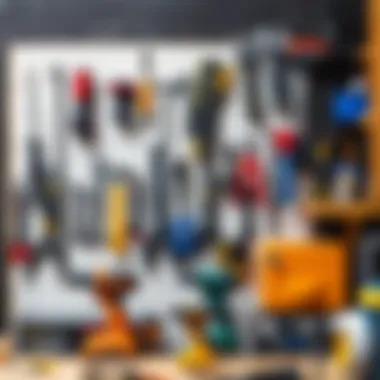
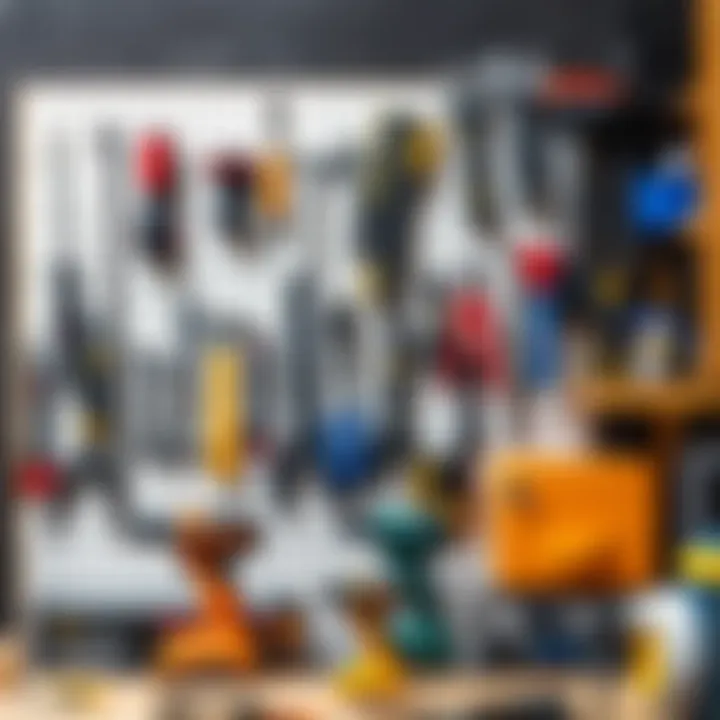
Intro
In today’s fast-paced world, finding effective ways to organize tools and materials can be a game changer for any DIY enthusiast or professional. Pegboard tool storage has emerged as a popular solution, offering flexibility and practical design that can cater to various needs. This guide will take you through the versatile world of pegboard, its applications, and how to customize it to fit your unique workspace.
From garages filled with tools to workshops where creativity flows, pegboard systems can transform any cluttered area into a model of efficiency. With its simple setup and endless possibilities for design, pegboards are not just functional but also an opportunity for personal expression in how you organize and display your tools.
As we go through this comprehensive guide, expect to learn about cutting-edge installation techniques one might not find in average tutorials, innovative customization ideas that could breathe new life into an old workspace, and essential maintenance advice to make the most out of your pegboard system. This information is designed for homeowners, designers, and DIY enthusiasts alike, making it a valuable resource for anyone looking to optimize their tool storage solution.
Intro to Peg Board Tool Storage
When it comes to organizing tools and maximizing workspace efficiency, peg board tool storage stands tall among the various solutions available. This approach offers not just a surface to hang tools but a structured system that transforms chaos into order. Understanding peg boards is fundamental for homeowners, designers, and DIY enthusiasts alike. It may seem like a simple board with holes, but the level of customization and practical application can benefit anyone looking to enhance their workspace.
Understanding Peg Boards
Peg boards are made from a variety of materials—often composite wood or metal—punched with evenly spaced holes to allow for a range of hooks and accessories. The beauty of peg boards lies in their adaptability. You can configure them to fit your specific needs, whether you’re using it in a garage, workshop, or even as a display in a retail setting. The straightforward assembly and flexible design make them a favorite choice.
Compared to other storage solutions, peg boards promote accessibility. Tools are not buried in drawers, making the search for the right tool a breeze. This is particularly crucial when you're in the middle of a project and time matters.
The Evolution of Tool Storage Solutions
The concept of tool storage has evolved over the years. In the past, tools were often stored in bulky, heavy cabinets or cluttered drawers. While these offers could suffice for simple tasks, they lacked the efficiency and organization needed for serious work. Over time, carpenters and handymen began seeking better options, which led to innovations like tool chests and wall-mounted systems. Yet, few succeeded in addressing both accessibility and organization as effectively as peg boards.
Today, peg board systems have witnessed significant advancements. Modern peg boards can accommodate specialized hooks for all sorts of tools—from wrenches to power drills, and they can even be customized with color finishes to match any aesthetic. As we dive into the benefits and various installation techniques, it becomes evident that peg boards combine functionality with a touch of style.
"Peg boards are like a blank canvas, waiting for the artist to create a functional masterpiece in their workspace."
By exploring the aspects of peg board tool storage, this article serves to equip readers with the knowledge to implement and optimize these storage systems in their own environments.
Advantages of Peg Board Tool Storage
When it comes to organizing tools and equipment, peg board tool storage is a game-changer. It has become increasingly popular among homeowners and designers alike due to its versatility and functionality. Understanding the advantages of peg board systems can help DIY enthusiasts unlock the full potential of their work spaces, elevating both efficiency and aesthetics.
Space Efficiency
One of the standout advantages of using peg boards is their ability to maximize vertical space. In a workshop or garage, every inch counts, and peg boards utilize walls that might otherwise remain empty. By hanging tools, you not only keep them off the floor but also reduce clutter on workbenches and shelves.
Having tools within arm's reach can save substantial time during projects. Imagine searching through a messy drawer filled with wrenches versus having them all neatly arranged just above your workbench. The latter is where peg boards shine, enabling faster access to your frequently used tools. In small spaces, the ability to go vertical is like striking gold. With proper arrangement, you can fit more items in a compact area without feeling overwhelmed by disorganization.
Customization Options
Another compelling aspect of peg board tool storage lies in the sheer number of customization options available. The boards come in different sizes, colors, and materials, which allows for personalization based on individual taste and needs. You might opt for a sleek metal board in a garage for a modern feel, or a traditional wooden peg board in a craft room for a rustic touch.
Beyond aesthetics, customization extends to how you choose to organize your tools. You can install hooks, bins, shelves, and various accessories that cater to your specific collections. For instance, using specific hooks designed for power tools versus hand tools can enhance functionality.
Moreover, the ease of reorganization makes peg boards particularly appealing. If your tool collection grows or your workflow changes, simply moving the hooks or adding more accessories can be done in a jiffy. This adaptability means your storage solution can evolve along with you, instead of forcing you to stick with a rigid layout.
Visibility and Accessibility
A well-organized peg board transforms the way you interact with your tools. One major benefit is visibility. When tools are hung on a peg board, they are clearly displayed rather than buried in a drawer or a cluttered toolbox. This visual aspect can prevent frustration, lost time, and, let’s be real, exasperation often felt while searching for a particular item.
Furthermore, visibility leads directly to greater accessibility. When you can see what you have, you're less likely to buy duplicates of tools you already own. This feature is especially useful for designers and DIYers who may have specialized tools buried under a pile of other items. What’s more, it encourages a clean workspace since you are more likely to return tools to their designated spot when they’re easy to see.
"In the world of home organization, peg boards open up possibilities that transform ordinary work spaces into organized havens."
Selecting the Right Materials
When embarking on the journey of organizing your tools with peg boards, the selection of materials stands as a cornerstone of the entire system. Choosing the right materials not only influences the performance and durability of your setup but also impacts the aesthetic appeal and functional efficiency of your workspace. Understanding the various types of peg boards available, including their strengths and weaknesses, ensures you make informed decisions that align with your specific needs.
Types of Peg Boards
There are various materials that peg boards can be made from, each offering unique benefits that cater to different environments. Here’s a rundown of the most common ones:
- Masonite Peg Boards:
- Plastic Peg Boards:
- Metal Peg Boards:
- Wooden Peg Boards:
- The classic choice for many DIY enthusiasts, Masonite offers a sturdy option that is easy to customize with paint or veneer. It typically has a smooth finish and can hold a decent amount of weight when mounted correctly.
- Light, versatile, and resistant to moisture, plastic peg boards are perfect for areas prone to humidity. Additionally, they resist corrosion and are available in various colors, providing a pop of personality to your garage or workshop.
- Durable and built to last, metal peg boards often accommodate heavier tools. These boards come with the added advantage of magnetic attachments, which can be a game changer for tool organization. Some metal options also feature a powder-coated finish to resist scratching and rust.
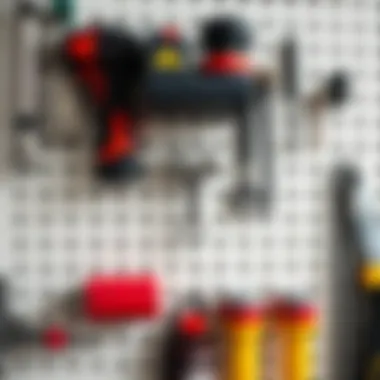
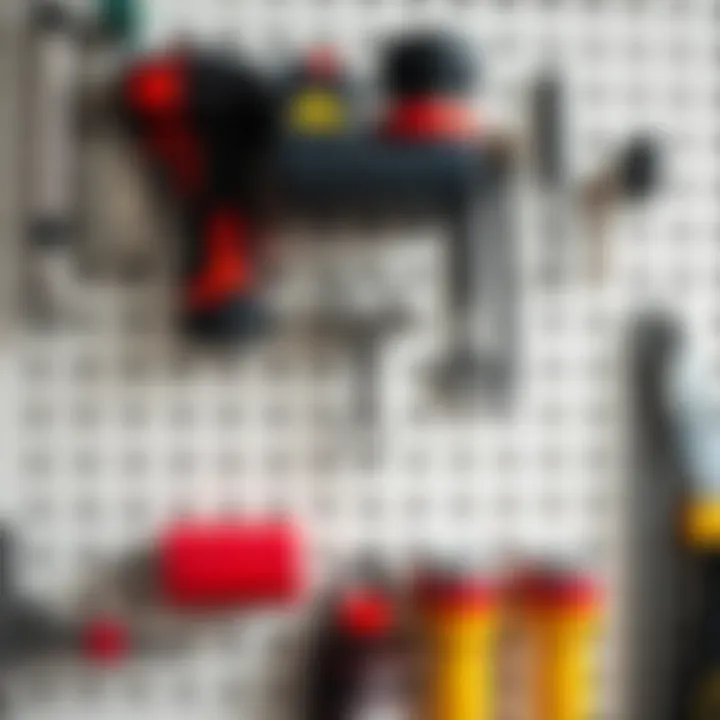
- If aesthetics matter or if you want that rustic, vintage charm, wooden peg boards are a fantastic choice. They can bear significant weight and can be crafted to suit your personal style. However, these should be treated with care to avoid water damage or warping.
Tip: When choosing the type of peg board, consider both the weight of the tools you plan to store and the environmental conditions of your workspace.
When assessing these options, keep in mind aspects like installation ease, weight capability, and how well they’ll complement the existing decor of your space.
Choosing the Right Hooks and Accessories
Alongside peg boards, selecting hooks and accessories that suit your needs is crucial. Not all hooks are created equal, so consider the following factors when making your choices:
- Weight Ratings: Different hooks come with varying weight capacities. Knowing how much weight each hook can handle is essential since misuse can lead to damage.
- Materials: Opt for hooks made of sturdy materials. Stainless steel hooks, for instance, resist rust and can withstand the test of time—ideal for a workshop environment.
- Hook Styles: There are numerous styles ranging from simple straight hooks to specialized tool holders that fit specific equipment. Deep hooks can hold heavier or bulkier items securely, while small, flat hooks may be better suited for lighter tools.
- Versatility: Look for hooks that can be adjusted or repositioned easily. The flexibility to rearrange your layout as needs change keeps your system adaptable.
Don’t forget to think about accessories that complement your peg board. Items like bins, shelves, and magnetic strips enhance organization and accessibility, making for a streamlined workspace.
Design Considerations
When it comes to setting up a peg board for tool storage, understanding design considerations is crucial. This part of your workspace can significantly influence how manageable and efficient your tool organization will be. A well-thought-out design not only optimizes the available space but also enhances the functionality and aesthetic appeal of your area. Let’s examine a few key aspects to keep in mind before diving into the nuts and bolts of your installation.
Optimal Placement in the Workspace
The placement of your peg board is one of those straightforward yet pivotal decisions. Ask yourself: where do you often reach for your tools? The peg board should be easily accessible, ideally at eye level or slightly above. If it's too high, you may end up retrieving tools cumbersome fashion, throwing off the convenience you seek.
Consider surrounding elements too. Adjacent workbenches or shelving units should inform your peg board placement. You want to avoid overcrowded areas that may cause chaos. For instance, if you install your peg board next to a messy shelf, the likelihood of bumping into something while retrieving tools rises. It's a good practice to leave about two feet of clear space in front of the peg board, allowing for easy maneuvering as you reach for essentials.
Creative Layout Ideas
Now that you’ve nailed down the placement, the layout can breathe life into your tool storage system. Not all peg boards need to follow a cookie-cutter design. Take a moment to consider function coupled with whimsy. Here are unique concepts:
- Zoning: Divide your peg board into sections based on tool types. For instance, group hammers and screwdrivers in one corner, while keeping pliers and wrenches in another. Not only does this make sense visually, it also streamlines workflow.
- Use Color Coding: Paint the background of your peg board or use colored hooks to create a visual cue system. Each color could represent different tool categories or usage frequency. For example, blue could indicate seldom-used tools while red marks the daily drivers.
- Layering Tools: Instead of just hanging tools, consider creating tiers. Hooks can be attached at various heights, allowing you to store larger tools at the bottom and smaller ones above, maximizing vertical space.
These approaches aren’t only practical; they also allow for personal expression, reflecting your personality and work style.
Incorporating Lighting Solutions
One aspect that often gets overlooked is lighting. A well-lit workspace is the unsung hero of any organizing system. Proper illumination can drastically improve visibility, making it easier to spot that elusive wrench or tiny screwdriver.
Consider these ideas for lighting integration:
- Directional Lighting: Installing flexibly mounted LED lamps above your peg board can illuminate specific areas without a harsh glare. This focused light makes it easy to see what you’re looking for.
- Backlighting: Some peg boards can benefit from backlighting to enhance visual effects and make tools pop. Use slim LED strips behind the board for a modern twist, or to simply highlight your organized setup.
- Task Lighting: This could be a small desk lamp that moves with you in the workspace. It helps by eliminating shadows from overhead lights where your items might get obscured.
Integrating these lighting solutions into your peg board design enhances usability. It’s more than just aesthetics; it improves the practicality of your work area. In the long run, it can lead to greater efficiency and less frustration when reaching for tools in low light conditions.
"The best spaces often contain surprising elements of creativity alongside practical design choices. When designing your peg board, don’t just think about function; allow room for innovation."
In summary, design considerations serve as the bedrock for an effective peg board setup. From optimal placement to creative layouts and thoughtful lighting solutions, each element plays a role in shaping how well your tools are organized and your workspace is utilized. The more personalized and functional the design is, the more it will resonate with everyday use.
Installation Techniques
When diving into the world of peg board tool storage, the installation techniques you choose are quite pivotal. Getting this process right ensures that the peg board serves its purpose effectively while looking good in your workspace. Let’s explore the components and benefits of ensuring a sound installation, as well as specific techniques that can make or break your effort.
Preparing the Wall Space
Before you even think about hanging up a peg board, it’s essential to prepare the wall space properly. This step is often overlooked, yet it plays a vital role in the success of your peg board installation. Start by assessing the condition of your wall; it should be clean and free of any debris that might interfere with securing the board.
Consider the following when preparing your space:
- Choose the Right Wall: Ideally, a flat wall is your best bet. If you have a studded wall, aim for those height levels where the studs are located, as they are more supportive.
- Clear the Area: Remove any items or fixtures that might obstruct your installation. Working in a clean area is not just about visual appeal; it also ensures safety as you work with tools.
- Leveling: Use a leveler tool to ensure that when you mount the peg board, it stays even. An uneven board can create imbalance and cause it to shift for the worse.
Taking these steps ensures that you lay the groundwork for a peg board that looks sharp and functions without a hitch.
Securing the Peg Board
This is the meat-and-potatoes of the installation process. Securing the peg board properly is crucial for the longevity and functionality of your tool organization system. A poorly secured board can lead to accidents – if it falls, it can damage tools, injure someone, or even ruin the wall.
Here are some steps you can follow:
- Mounting Hardware: Select screws, anchors, or a mounting kit specifically designed for peg boards. These can handle the weight of tools and withstand tugging when you pull items off the board.
- Attach to Studs: If possible, secure your peg board to wall studs. This provides greater strength and stability compared to just drywall. You’d hate to have your prized tools tumble down.
- Check for Movement: After securing, gently push the board and see if there’s any movement. If it wobbles, you might need to reconsider your mount points.
By ensuring the peg board is firmly secured, you establish a reliable storage solution that doesn’t skimp on safety.
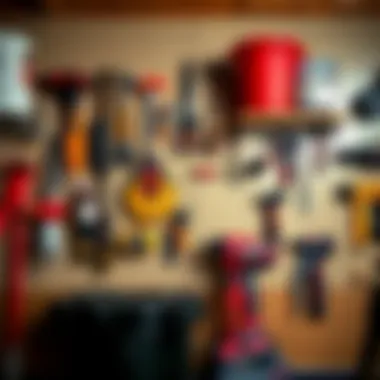
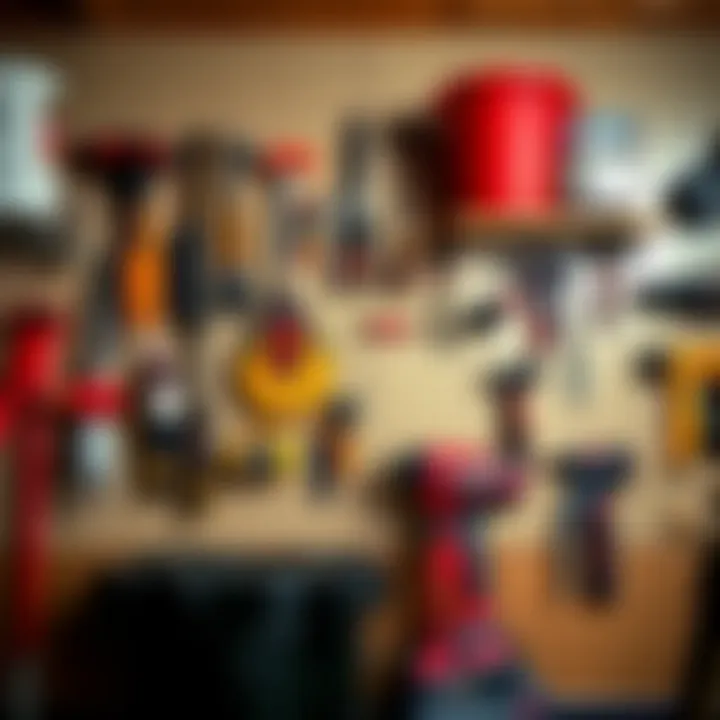
Mounting Accessories Properly
Once your peg board is up, the next logical step is to address how you’re going to utilize it. Mounting accessories rightly is as important as placing the board itself. Improper mounting can lead not only to tools falling but also a cluttered appearance which defeats the purpose of having the peg board in the first place.
Take these considerations into account:
- Match Hooks with Use: Select hooks that are sized appropriately for the tools you plan to hang. If you opt for heavy-duty tools, heavy-duty hooks are a must.
- Spacing and Arrangement: Think about visibility and access. Don't just line everything up willy-nilly; arrange tools in a way that makes sense for your workflow. For example, keep frequently used items at eye level to promote ease of access.
- Regular Checks: After hanging your tools, take a moment to check that each accessory is secured properly. This is especially important when you store heavier items, as they might shift over time.
In the end, mounting your accessories properly is about marrying utility with organization—creating an environment that works for you.
Proper installation fosters not just efficiency, but also safety, leading to successful usage of your peg board system over time.
By giving the proper attention to each stage of the installation process, you can transform your wall into an organized workspace that makes your tools easy to find and access.
Innovative Customization Ideas
Innovative customization ideas are essential for anyone looking to maximize the efficiency of peg board tool storage. Such ingenuity enables individuals to transform an ordinary storage solution into a tailored system that meets specific needs, aesthetics, and usability. When you personalize a peg board, you not only enhance functionality but also create a workspace that feels uniquely yours.
Effective customization involves a thoughtful consideration of various elements, including color, finishes, and additional storage solutions. By integrating these innovative ideas, you can take your peg board from a basic organizational tool to a vibrant feature of your garage or workshop. Let's delve into the specifics.
Color and Finish Options
Color and finish can dramatically change the look and feel of a peg board system. Rather than sticking to the traditional wood or plain white plastic, consider various finishes that speak to your individual taste and the overall style of your space.
- Bold Colors: Painting your peg board in a bright hue can make your tools pop and add energy to your workspace. Shades like electric blue or vivid orange can serve as a backdrop for tools while keeping the environment stimulating.
- Textured Finishes: Textured boards can add a unique element to the design while providing a more robust surface for hooks to grip. For instance, a galvanized steel finish can offer industrial charm, fitting for a modern workshop.
- Magnetic Paint: Applying magnetic paint turns any board into a magnet-friendly surface. This feature allows magnetic tools to be stored without hooks, enabling quick access and organization.
- Chalkboard Paint: This finish invites creativity, letting you jot down quick notes or reminders directly on the board. Imagine being able to write down your next project or what tools need to be replenished, right where you store them!
In essence, the right colors and finishes not only enhance aesthetics but also create a more enjoyable workspace.
Integrating Other Storage Solutions
While peg boards are a powerful tool on their own, integrating additional storage solutions can create an even more effective organization system. This overlap allows for optimization of vertical space and ensures that all necessary tools are within reach:
- Shelving Units: Place shelving above or alongside your peg board to house larger items like bins or power tools. This helps in keeping the peg board focused on frequently-used handheld tools and supplies.
- Drawers or Cabinets: For tools that are less frequently accessed or more valuable, consider installing drawers below the peg board. This can keep your workspace clutter-free while keeping your prized tools safe.
- Wall-Mounted Bins: Combine peg boards with clear plastic bins mounted on the board to store smaller items such as screws, nails, and bolts. This improves visibility and keeps everything organised at the same time.
- Tool Trolleys: Integrating a mobile tool trolley can add flexibility. Tools that you use most can be kept on the trolley while less-used items can remain on the peg board. You can wheel it around as necessary, giving you the best of both worlds.
By considering these integrations, you can create a systems approach to your storage, making your workspace not just organized but also efficient.
Utilizing Magnetic Tools
Magnetictools are a clever innovation that can enhance your peg board's functionality. These tools not only save space but also are designed for easy accessibility.
- Magnetic Tool Holders: These are strip magnets that can be mounted directly on the pegboard or the wall. They’re great for items like screwdrivers, pliers, and scissors, allowing for quick grab-and-go access.
- Magnetic Trays: These trays catch small items prone to being misplaced, such as nuts, bolts, and screws. Attaching them to the pegboard can create a designated area for these smaller components, clearing up workspace.
- Magnetized Tool Sets: Some manufacturers produce magnetic tool sets that can attach directly to the pegboard. This can simplify storage while providing impressive visibility as well.
- Versatile Adhesive Magnets: If you have tools that do not naturally possess magnetic properties, attaching adhesive magnets will allow them to stick to the pegboard. This offers endless possibilities for unique storage ideas.
Utilizing these magnetic tools can change the way you interact with your workspace, offering a new level of organization and accessibility that brings efficiency to your daily tasks.
As you can see, innovative customization ideas for peg boards lead to a highly personalized setup that fulfills both practical needs and aesthetic aspirations. By considering color and finish options, integrating various storage solutions, and embracing magnetic tools, you can create an organized and inviting workspace that caters perfectly to your projects.
Maintenance of Peg Board Systems
The importance of maintaining peg board systems cannot be overstated, especially for those who rely on them for efficient organization in workshops, garages, or craft rooms. Just like you wouldn’t drive a car without regular oil changes and tire rotations, neglecting maintenance on peg boards can lead to disorganization or even accidents. A well-kept peg board not only extends the lifespan of your tools but also enhances safety and efficiency in your workspace. This section dives into the nitty-gritty of maintenance, encompassing cleaning practices and repair strategies to keep that peg board in tip-top shape.
Cleaning and Upkeep
To keep your peg board functional and visually appealing, regular cleaning and upkeep are essential. Dust and grime can accumulate over time, making it difficult to see the tools and materials you need. Here’s how to keep your peg board looking sharp:
- Dust Regularly: Use a soft cloth or a small brush to sweep away dust. You could do this once a week or every couple of weeks, depending on the amount of activity in your workspace.
- Spot Clean: For pesky stains or marks, a mild cleaning solution mixed with water works wonders. Just spray it lightly on a cloth (not directly on the board) and wipe it down. Avoid excessive moisture since peg boards, especially wooden ones, can warp.
- Inspect Hooks and Accessories: Regularly check hooks and accessories for any signs of rust or wear. If you spot corrosion, it might be time to replace them.
- Avoid Overloading: Take care not to overload your peg board with too many tools or heavy items. This can stress the board and compromise its integrity over time.
By dedicating a little time to cleaning and upkeep, you ensure that your peg board remains an efficient storage solution, ready to assist you with your DIY or professional tasks.
Assessing Damage and Repairs
Even the best-maintained peg boards can fall victim to wear and tear. Nature of the beast, right? Whether it’s from heavy tools hanging too long or accidental bumps, knowing how to assess and repair damage is important:
- Check for Warping: If you see any bending or warping, that’s a strong indicator that it needs attention. Take measurements for replacement or reinforcement methods.
- Inspect Holes: Over time, holes can become stripped or worn out. Adjusting hook placements or filling in unused holes with wood filler might do the trick.
- Reinforcing Mounts: Sometimes, just tightening the mounts can do wonders. Loose screws can lead to instability, so be sure to check them periodically.
- Replace Sections: If you find that part of your peg board is damaged beyond repair, consider replacing only that section instead of the entire board.
In the grand scheme of things, handling repairs promptly helps maintain a secure setup. Like any system, the integration of good upkeep and timely repairs creates a sustainable storage solution.
"A well-maintained peg board is the backbone of an organized workshop."
By prioritizing cleaning and repairs, you cultivate a storage solution that works harmoniously with your needs and enhances your overall productivity.


For more information on tool storage and organization, check resources such as Wikipedia and Britannica.
By following these maintenance guidelines, you can ensure that your peg board remains a cornerstone of your workspace for years to come.
Safety Considerations
When setting up a peg board for tool storage, safety isn't just an afterthought – it’s fundamental. Proper safety measures can prevent accidents and injuries, ensuring your workspace remains efficient and functional. Understanding a few key elements can save a lot of trouble down the line. Let's delve into the two vital topics under this heading: weight limitations and securing tools properly.
Weight Limitations
A peg board is a handy storage solution, but it’s crucial to understand its limits. Each peg board has a specific weight capacity that must be respected to avoid falls and damage. Miscalculating the weight of the tools you hang can lead to a precarious situation. Here are some points to consider:
- Material Matters: The type of peg board affects its weight limits. For example, fiberboard generally has lower weight thresholds compared to heavy-duty metal versions.
- Distribution is Key: Evenly distributing weight across the board will help prevent sagging or breaking. Grouping many heavy items together will likely lead to issues.
- Check Manufacturer Guidelines: Always refer to manufacturer specifications for weight limits. These provide a baseline for safe usage.
Even if it seems like common sense, it bears repeating: exceeding weight limits can lead to tools crashing down. This not only risks damaging the tools but also poses serious injury risks.
Securing Tools Properly
Ensuring tools are secured properly is another cornerstone of safety in a peg board setup. If tools aren’t fastened as they ought to be, they can easily slip out of place or fall off when accessing or repositioning them. Here’s a quick rundown to help you secure your tools:
- Choose the Right Hooks: Different tools call for different hooks. For example, larger tools might require reinforced varieties, while smaller items can use standard hooks.
- Organize by Frequency: Place the tools you use most often at eye level, making them both accessible and easy to secure. Less frequently used tools can be stored further up or at less accessible spots.
- Test Stability: After placing a tool, give it a gentle tug to see if it feels secure. If it shifts, re-evaluate the hook or the peg placement.
"A well-secured tool is a step towards a safer workspace, reducing potential hazards significantly."
Peg Board Alternatives
In the quest for optimal organization in workshops and garages, peg boards often come to mind. However, they aren't the only game in town. As we dig deeper into storage solutions, it’s essential to explore peg board alternatives that might better suit individual needs, give flexibility in design, and provide efficiencies that peg boards may not. Every workspace is unique, and so is every tool storage requirement.
Benefits of Exploring Alternatives
Utilizing peg board alternatives can lead to:
- Enhanced Organization: Certain systems might offer improved categorization than peg boards. For instance, slatwalls or cabinets can provide designated spaces for specific tools.
- Increased Weight Capacity: Some solutions can handle heavier tools, ensuring that items remain secure.
- Aesthetic Choices: Alternatives often come in various styles and finishes, allowing for a tailored look that fits the decor of the space.
With these benefits in mind, let’s dive into two noteworthy alternatives: Slatwall systems and storage cabinets or drawers.
Slatwall Systems
Slatwall systems present a formidable choice when it comes to versatile organization. Made from sheets of medium-density fiberboard (MDF), these systems allow for a series of horizontal grooves that makes them uniquely adaptable to various accessories.
- Versatile Components: Unlike peg boards, slatwalls accept a wide array of hooks, shelves, and baskets. This not only enhances usability but also caters to how tools might be stored on an individual basis.
- Weight Distribution: Slatwall systems generally distribute weight more evenly, enabling the storage of larger tools or equipment without the worry of sagging or breaking.
"Slatwall systems empower users to customize their storage with ease, adapting as their toolkit grows or changes."
- Easy Installation: While peg boards often require specific spacing for hooks, slatwall systems can accommodate attachments anywhere along the wall, allowing for spontaneous changes in setup.
- Aesthetics: Available in a variety of colors and finishes, slatwall systems can integrate seamlessly into any setting, elevating the overall view in addition to their practical use.
Storage Cabinets and Drawers
For those seeking a more enclosed option, storage cabinets and drawers can be a significant step away from the open wall systems of pegboards. They offer unique advantages:
- Security and Protection: Cabinet systems frequently include doors or locks, protecting tools from dust, vandalism, or unauthorized use.
- Organization by Category: Different compartments can be ideal for organizing tools into categories, such as hand tools, power tools, or consumables like screws and nails.
- Visual Appeal: A well-designed cabinet not only keeps tools organized but also contributes to a tidier appearance. This might be vital in shared spaces or commercial environments.
- Storage Solutions for Smaller Tools: Drawers allow for comprehensive organization, making sure that even the tiniest bits and bobs don’t get lost in the shuffle.
Ultimately, while peg boards are useful, alternatives can meet needs that peg boards may falter in addressing. As you contemplate your storage solutions, take the time to assess your workspace, tool selection, and personal preference. Incorporating slatwall systems or storage cabinets/drawers can yield more personalized and efficient management of your most essential tools.
End
In wrapping up this comprehensive guide, it's essential to recognize the vital place peg board tool storage holds in crafting a functional workspace. The convenience it offers denies the notion that effective organization is purely for the neat-freaks among us. Rather, it elevates efficiency, allowing homeowners, designers, and DIY enthusiasts to streamline their tools in an inviting and accessible manner.
Recap of Benefits and Considerations
When considering peg board tool storage, several benefits stand out:
- Space-Saving Design: Peg boards utilize vertical space, which can be a game-changer in cramped workshops or garages.
- Customizability: The adaptable nature of peg boards means they can evolve with your tool needs. As you acquire new tools, the layout can shift without the hassle of complex renovations.
- Enhanced Visibility: With tools hung on a wall, you can see everything at a glance. Forget rummaging through drawers or boxes. Everything you need is there in plain sight.
However, some considerations must not go overlooked:
- Weight Limits: Ensure not to overload pegs or hooks. Knowing the weight capacity of your selected board and the accessories is paramount.
- Placement Matters: The efficiency of peg boards relies heavily on their positioning within your workspace. Placing it within arm's reach can save lots of time.
Final Thoughts on Peg Board Tool Storage
Ultimately, peg board systems serve as more than just a method of storage; they symbolize organization and creativity in home projects. Whether you choose a minimalistic white peg board or one adorned with vibrant colors, the aesthetic can boost your work area, making it as much a reflection of your style as it is a practical solution.
In essence, choosing peg board tool storage can transform not just the way you store tools but also the overall workflow in your workspace. Rethinking the organization can lead to heightened productivity and satisfaction in any project you tackle next.
As you embark on this journey towards a better-organized workspace, remember that the right tools, paired with an effective storage solution, can unlock potential previously hidden away in clutter.
"The only way to do great work is to love what you do." — Steve Jobs
For further insights and ideas, consider visiting resources like Wikipedia, Britannica, and communities such as those found on Reddit to exchange ideas and experiences.















